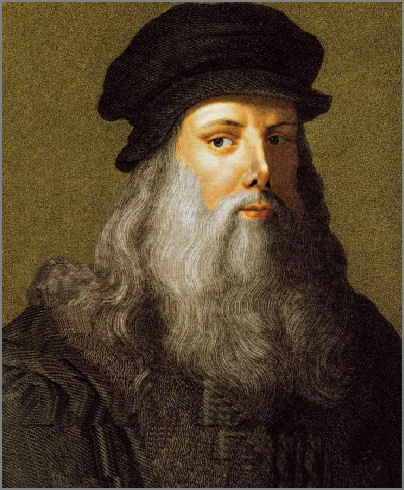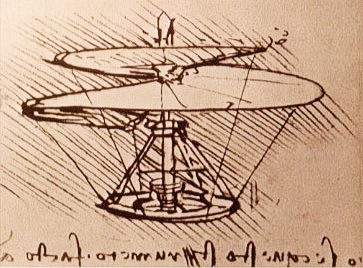As we all know, Leonardo da Vinci was an artist extraordinaire. His art is legendary; especially the “Mona Lisa”, “The Last Supper” and “The Vitruvian Man.” On top of his artistic ability, da Vinci was also a musician, mathematician, engineer, anatomist, geologist, cartographer, botanist and writer. His genius, perhaps more than that of any other figure, epitomized the true meaning of the term “Renaissance Man”. But, this being Inventor Monday, we decided to focus on Leonardo’s amazing inventions—some of which were hundreds of years ahead of their time. So, let’s meet this remarkable man and learn about some of his incredible inventions!
 Leonardo was born on April 15, 1452, in Vinci, Italy, just outside of Florence. He was an illegitimate child, and when his mother married another man and moved to a neighboring town, Leonardo was left to be raised by his father. When he was fifteen, Leonardo became the apprentice of Andrea del Verrocchio in Florence, who owned one of the best artistic workshops of the time. There, he learned many of the crafts he would later use, such as drafting, chemistry, metallurgy, mechanics, painting, sculpting and modeling. Even as an apprentice, Leonardo demonstrated enormous talent, and by the time he was twenty, Leonardo qualified as a master in the Guild of St. Luke, the guild of artists and doctors of medicine.
Leonardo was born on April 15, 1452, in Vinci, Italy, just outside of Florence. He was an illegitimate child, and when his mother married another man and moved to a neighboring town, Leonardo was left to be raised by his father. When he was fifteen, Leonardo became the apprentice of Andrea del Verrocchio in Florence, who owned one of the best artistic workshops of the time. There, he learned many of the crafts he would later use, such as drafting, chemistry, metallurgy, mechanics, painting, sculpting and modeling. Even as an apprentice, Leonardo demonstrated enormous talent, and by the time he was twenty, Leonardo qualified as a master in the Guild of St. Luke, the guild of artists and doctors of medicine.
Despite his talent, times were hard for artists, and even a master like Leonardo had to expand his clientele to make money. So, he adapted his drawing skills to the more lucrative fields of architecture, military engineering and weapons design. Leonardo landed a job working for the Duke of Milan for whom he developed ideas for weapons including missiles, multi-barreled machine guns, grenades, mortars and even a modern-style tank. As an architect, Leonardo proposed building a bridge to connect Istanbul across the Bosporus—a span of 720 feet. It was an outlandish vision at the time, and was ridiculed as impossible (ironically, modern engineers have determined that the bridge would have been completely feasible).
As it turns out, most of da Vinci’s inventions never made it to prototype in his lifetime, probably because he couldn’t convince one of his wealthy patrons to finance construction of his designs. Luckily for us, many of the sketches and diagrams of his inventions survived, and in the hundreds of years since, creative engineers have been able to not only build working prototypes of his designs, but also build practical machines based on his drawings. Inventions such as the parachute, the helicopter, underwater breathing devices and even a car that uses a spring-driven mechanism similar to that in a clock. And, believe it or not, it has been said that Leonardo actually built a working robot that he used primarily for entertainment at parties thrown by a wealthy patron.
 Leonardo’s genius still resonates today, some 500 hundred years after his death. Books and movies such as The Da Vinci Code are widely popular, and a new television series, DaVinci’s Demons, is about to premier on the STARZ network. His art draws record crowds whenever it is exhibited and his scientific discoveries in the fields of anatomy, zoology, botany, geology, aerodynamics and hydrodynamics are staggering. But, it is his invention ideas that were so amazingly ahead of their time—such as the “flying machine”—which make it seem as if he could actually see the future. Leonardo da Vinci has been called the “smartest man that ever lived,” and considering all the amazing things he invented, we wholeheartedly agree.
Leonardo’s genius still resonates today, some 500 hundred years after his death. Books and movies such as The Da Vinci Code are widely popular, and a new television series, DaVinci’s Demons, is about to premier on the STARZ network. His art draws record crowds whenever it is exhibited and his scientific discoveries in the fields of anatomy, zoology, botany, geology, aerodynamics and hydrodynamics are staggering. But, it is his invention ideas that were so amazingly ahead of their time—such as the “flying machine”—which make it seem as if he could actually see the future. Leonardo da Vinci has been called the “smartest man that ever lived,” and considering all the amazing things he invented, we wholeheartedly agree.
Sources:
Photo 1: http://www.leonardodavinci.net/
Photo 2: http://commons.wikimedia.org/wiki/File:Leonardo_da_Vinci_helicopter.jpg